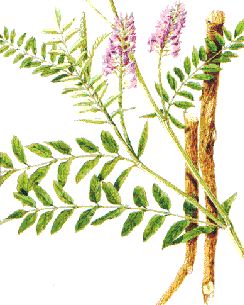
Periodically, I’ve discussed various herbal or
botanical approaches (i.e., phytomedicines) that promote neuronal health
and regeneration. For example, one of mankind’s most commonly used
herbal remedies Ginkgo biloba inhibits
post-injury lipid peroxidation, a biochemical process that mediates
further damage to the injured spinal cord. In another example,
Mimosa pudica (sensitive or
touch-me-not plant) is an herbal remedy of India’s ancient Ayurvedic
healing tradition, which has been shown to stimulate peripheral-nerve
regeneration.
In this update, I’ll discuss Buyang Huanwu
Decoction (BYHWD), a Chinese herbal medicine that has been
used for centuries to treat a variety of disorders, including paralysis.
From a Traditional Chinese Medicine viewpoint, it’s used to invigorate
the body, enhance blood circulation, and activate qi flow through energy
meridians. The decoction contains extracts of various Chinese herbs,
including astragalus (illustration), dong quai, red peony root, Rhizoma
Chuanxiong, peach seed, safflower, and, perhaps the
decoction’s
crème de la crème, earthworm extract.
Demonstrating that ancient wisdom often has much
validity, scientific studies indicate that BYHWD, indeed, exerts
neuroprotective and regenerative effects. For example, animal research
suggests that this herbal decoction can promote nerve regeneration after
stroke and both peripheral-nerve and spinal-cord injuries.
In the case of SCI, Dr. An Chen et al
(China) have evaluated BYHWD in a rat model of injury in which one side
of the cord was transected at the cervical level (J Ethnopharmacol
2008; 117(3)). After transection, the rats were administered BYHWD or
distilled water for eight weeks through a stomach tube. After this time
period, the number of surviving neurons on the cord’s injured side for
both BYHWD- and water-treated groups were compared to the neuron level
on the non-injured side. Compared to the uninjured side, 78% of the
neurons remained with the BYHWD-treated rats compared to only 58% of the
water-treated rats. In other words, the BYHWD decoction reduced neuron
loss from 42 to 22%.
In addition, cell bodies of surviving neurons
atrophied by 64% in the water-treated controls compared with 35% in the
BYHWD-treated rats. Hence, BYHWD enhanced the robustness of surviving
neurons.
Especially significantly, only in the BYHWD-treated
rats did axons regenerate through the injury site. And, as expected with
such regeneration, these rats recovered more forelimb function, the
physical area affected by this experimental injury.
In another study, Dr. Lihong Fan and
colleagues (China) evaluated the effects of BYHWD in a rabbit model of
SCI (J Tradit Chin Med 2006; 26(2)). In this model, injury was
generated by temporarily shutting off blood flow to the spinal cord’s
lumbar region (i.e., ischemia), affecting hind-limb function. The
rabbits were treated with either BYHWD or saline starting seven days
before injury and continuing two days after injury. Hind-limb function
was then measured using a scale ranging from 0 (complete paralysis) to 5
(normal function). Forty-eight hours after injury, the BYHWD-treated
rabbits averaged 3.4 on this scale compared to 2.6 for the
saline-treated controls.
With respect to peripheral-nerve injuries, Dr.
Yueh-Sheng Chen et al (Taiwan) demonstrated that BYHWD stimulates
growth in regenerating nerves (Am J Chin Med 2001; 29(3-4)). In
this study, a 10-millimeter gap was created in the rat sciatic nerve
(running down the leg from the back) and then bridged by a
silicon-rubber tube. Regeneration across the gap was compared in BYHWD-treated
rats and control animals who received no BYHWD. Nerves regenerated
across the gap in 89% percent of the BYHWD-treated rats compared to only
70% of controls.
BYHWD may mediate its neuroprotective effects
through several physiological mechanisms. For example, scientists have
shown that BYHWD 1) stimulates the outgrowth and differentiation of
neuronal stem-cell neurites (processes budding out from immature
neurons, such as developing dendrites and axons); 2)
inhibits apoptosis – a post-injury, programmed death of spinal-cord
cells; and 3) decreases free radical generation and associated lipid
peroxidation, biochemical processes that cause further damage to
the injured cord.
Conclusion
Although these BYHWD-related improvements seem
modest, it is important to note that studies have shown that substantial
physical function can be retained even if only a relatively small
proportion of neurons survive the injury. In this regard, we should also
note that the post-injury putative standard of care methylprednisolone
has statistically modest at best effectiveness - one senior scientist
noting “Evidence of the drug's efficacy and impact is weak and may only
represent random events” (Hurlbert RJ, J Neurosurg 93(1 suppl), 2000).
Perhaps, given such reservations, we need to open-mindedly evaluate the
therapeutic potential of various phytomedicines coming out of the wisdom
of ancient healing traditions.
Adapted from article appearing in April 2009 Paraplegia News (For subscriptions,
call 602-224-0500) or go to
www.pn-magazine.com.
TOP